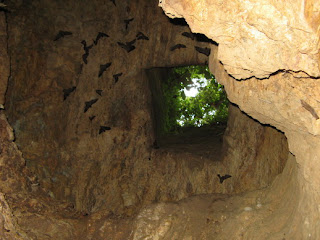I heard about the existence of an old gold mine in Negeri Sembilan but could find very little information about it, although it has been mentioned in the New Straits Times 2007 as it seems the local villagers want to turn it into a tourist attraction.
I was unable to find any accurate history about the mine. The NST says it was worked in the 19th and 20th century and has a series of tunnels which stretch 80km. This of course I didn't believe. Talking to the man who led us to the tunnels, he said the workings closed before the Japanese arrived in the Second World War.
Anyway I wanted to take a look so made a suggestion to Jan that we do a day trip there and he readily agreed.
The day started too early for me when a rooster started crowing at about 6.30am so I was up to see the sunrise. Even though I live in a suburb near to KL it's rural enough to have chickens and roosters!
We drove to Tampin where we stopped for brunch and also visited the Gurdwara Sahib Sikh temple.
I knew the mine was somewhere near Kampung Air Kuning Selatan, which is in the direction of Gemas, so we headed there. We got sidetracked when we stopped to take photos of a Chinese cemetery and the Kuil Sri Maha Mariamman Indian temple.
what fruit is this?
In the village we found someone who knew about the mine and he arranged for a friend to lead us there, so we had some chicken rice whilst waiting.
The NST report suggested that the mine tunnels may no longer be accessible due to cave-ins, so I was very happy when we reached the entrance and found we could go in. First sight of th entrance with rubbish left by the Bomba -
From the entrance chamber we had a choice of 2 routes, both of which were wet with some dubious looking water. Jan took the plunge and stepped in and I quickly followed. I hate that first moment of having to get my shoes wet. The water was initially ankle deep but I didn't like the smell we stirred up, which reminded me of human sewage. I couldn't believe it was sewage, but it definitely wasn't pleasant.

The Malaysian Bomba (Fire Dept) had been here recently and had taped off a route through the tunnels. Unfortunately they had also left boxes of rubbish outside the cave and up on the hill. It was mostly water bottles and polystyrene containers. If they had bothered to collect their rubbish in boxes, why on earth couldn't they also remove the boxes, rather than leave them for the animals to scatter.
The passages were full of bats, which were flying all around us, and several of them gently collided with us. However as most of the passages led on, most of the bats were able to fly ahead of us. Incidentally the bats are harmless and there is no need to worry about them or to disturb them.
| cockroaches |
shafts down
The tunnels were a uniform size and there was little sign of how they had been dug out by hand, but the rock seemed quite soft.
low flying bats
The tunnel came back to the entrance chamber, so we decided to go in for another round, this time exploring some passages taped off by the Bomba. Here the water had no smell so I guess the bad smell in the other passages was due to the mud being churned up by previous visitors.
cleaner water
coming up a climb
 |
| yet more bats |
Having explored the tunnels, we washed out feet in the stream outside, then we climbed up the hill where we saw many shafts which had been dug. Some were just trial shafts, but others connected to the mine below.
It was an interesting visit, and now I am curious to know the history of the place and to know if there are similiar tunnels in the area.
You can see Jan's photos
© Liz Price
No reproduction without permission




































